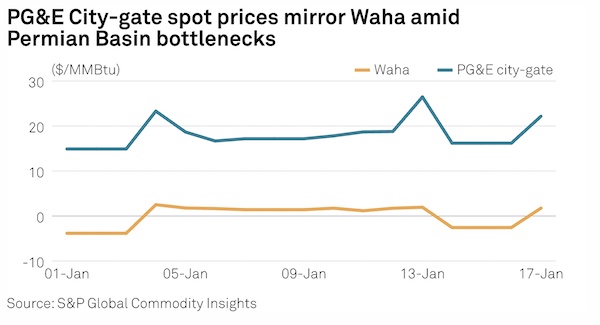US spot gas prices rebound after holiday weekend with colder weather on deck

US spot natural gas prices in a few regions rebounded coming off the Martin Luther King Jr. Day holiday weekend, with traders now anticipating prices well above $20/MMBtu throughout the US West for the remainder of January.
Spot gas prices for next-day flows across the US Southwest and Pacific Northwest rose at multiple locations in Jan. 17 trading, including a $6 rise at the PG&E city-gate hub in Northern California, to $21.16/MMBtu, according to preliminary settlement data from S&P Global Commodity Insights. Prices at hubs in the Rocky Mountains soared even further in an attempt to lure gas westward, with spot prices at El Paso Natural Gas in the San Juan Basin of Colorado rising nearly $12 on the day, to $19.66/MMBtu.
The US West continued to face the highest spot gas prices for any region in the US, but was not alone in seeing a price hike in Jan. 17 trading. In the Upper Midwest, both Chicago city-gate and MichCon city-gate jumped around 7 cents to around $3.11/MMBtu and $3.21/MMBtu, respectively, for next-day flows.

US gas bulls helped push futures markets slightly upward in Jan. 17 trading, with the front-month Henry Hub contract rising by 33 cents to a $3.74/MMBtu peak around 10 am ET, before tempering to a $3.586/MMBtu settle on market close, according to data from CME Group. Phil Flynn, senior market analyst at the Price Futures Group, said “signs that winter may return is giving the [US] natural gas market a pretty good oversold bounce,” in a note sent to clients Jan. 17.
Weather backdrop
Recent weather forecasts suggest that late January will bring weather more consistent with normal seasonal trends, after a relatively warm start to January sapped demand for heating-linked gas across the US in recent weeks.
Forecasts from weather data provider CustomWeather point to an average temperature of 26 degrees Fahrenheit in the Rockies for the balance of January, significantly under the 33 F average recorded across January in the region over the last five years. The Pacific Northwest and Southwest are likewise expected to face temperatures 3 F and 5 F below the January five-year average over the next two weeks ending Jan. 31. Temperatures in the Northeast and Midcontinent are expected to remain above the five-year average in coming weeks, but slightly below levels recorded month to date in January.

These cooler weather patterns could cause an about-face for domestic US gas demand in January, after hotter-than-expected temperatures in the US and in Europe — a major source of US LNG demand — led Goldman Sachs analysts to dub this season “the winter that wasn’t” in a note sent to clients earlier this month.
Cold weather in the US Southwest has already prompted a boost in regional gas demand to begin the week, with residential-commercial demand in the area rising to 7.7 Bcf/d on Jan. 17, according to data from S&P Global, marking a 10% increase from the prior day and the highest mark recorded for the res-comm segment in roughly one month. Total West gas demand is projected to increase from 13.69 Bcf/d on Jan. 17 to about 15.54 Bcf/d on Jan. 20.
Traders were busy pricing in forecasts for continued cold weather in the West and Rockies in Jan. 17 trading. At PG&E city-gate, the January balance-of-month contract is now trading at $27/MMBtu, up $6 from last session’s close, while the balance-of-month contract at Northwest Pipeline’s Rocky Mountains delivery point rose around $6, to $25.25/MMBtu, according to data from Intercontinental Exchange.
Source: Platts

 Hellenic Shipping News Worldwide Hellenic Shipping News Worldwide, Online Daily Newspaper on Hellenic and International Shipping
Hellenic Shipping News Worldwide Hellenic Shipping News Worldwide, Online Daily Newspaper on Hellenic and International Shipping





















 PG-Software
PG-Software